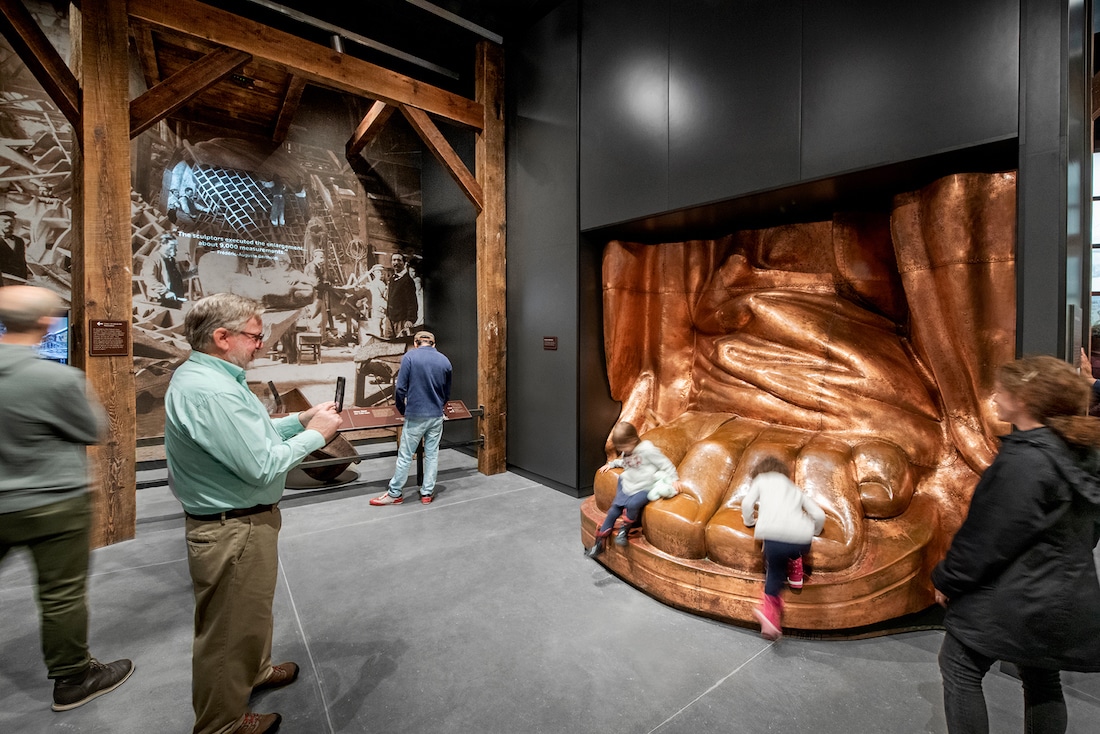
The new Statue of Liberty Museum viewed at sunrise. The building designed by FXCollaborative, with experience and exhibit design by ESI Design, will allow for expanded access to artifacts, content and exhibits on the history of the Statue of Liberty, its original concept, design, construction, and 1986 centennial restoration.
Photographs © David Sundberg / Esto
The Statue of Liberty is one of the United States of America's most admired landmarks. Every year, 4.5 million people flock by ferry to see the iconic sculpture, which has stood as a symbol of independence since 1886. In addition to ascending Lady Liberty's 354 stairs for a sweeping view of the New York City skyline, many of these guests hope to gain a better understanding of her history in an immersive, interactive, and accessible way—a concept at the core of the new and improved Statue of Liberty Museum.
For decades, visitors to the Statue of Liberty could learn more about the sky-high sculpture's story in a gallery. Nestled in its pedestal, the original Statue of Liberty Museum presented a relevant collection of historic objects owned by the National Park Service. Unfortunately, catching a glimpse of these artifacts was not guaranteed to all guests; due to stringent security restrictions, access to the statue itself is severely limited. This means that, when prohibited from entering the monument, guests were also barred from the museum, leaving them without any sort of educational—or even entertaining—experience.
Resolving the issue of accessibility has been a driving force for ESI Design, the creative studio behind the new museum's experience and exhibit design. Taking full advantage of all that the new FXCollaborative-designed building has to offer—including 26,000 square feet of space separate from the hustle and bustle of the statue—ESI Design has replaced and reimagined the former museum with a state-of-the-art site fit for Lady Liberty herself.
To find out more about the ins-and-outs of the new Statue of Liberty Museum, we recently spoke to Nick Hubbard of ESI Design. Responsible for the studio's Content + Activity Design, Hubbard gives us a sneak peek at the groundbreaking project in our exclusive interview below.

This project has been a collaborative effort, led by a team of designers, strategists, storytellers, technologists, artists, and other experts. How did such a diverse team come together?
Having a diverse team and a multidisciplinary approach is part of the ESI Design ethos. We don’t focus on just one aspect, such as the technology, the software, or the content, but on how all of these different parts work together in the physical space to create a unique experience. Our team works together from day one until it’s done ensuring a cohesive design that focuses on the visitor experience. We think this combination makes ESI Design a great place to work, but also terrific at changing how people connect with brands, organizations, cultural institutions and, most importantly, each other.

Visitors will enter the Engagement gallery, designed by ESI Design, and follow Liberty’s story along curved walls that evoke the copper folds of the Statue. From here we can also see ‘Becoming Liberty’ exhibit where visitors can take self- portraits that join evocative, symbolic images in a dynamic visual conversation about freedom.
Photographs © David Sundberg / Esto
Accessibility is a top priority for the new Statue of Liberty Museum, as current capacity restrictions severely limit access to the museum inside the statue’s pedestal. How does the museum plan to provide a fulfilling experience for guests unable to enter the statue?
On a peak summer day, there are over 25,000 visitors on Liberty Island but due to the security restrictions you mention, only 20% are able to enter up into the interior of the Statue or were able to visit the original gallery in the Statue’s Pedestal that the new Statue of Liberty Museum replaces and reimagines. ESI Design translated many of the elements from the National Park Service’s collection into a larger space, so that more visitors can learn the Statue’s complex history and significance.
We then go further, expanding the storytelling using immersive and interactive digital media. For example, the museum’s opening is an immersive film that features a cinematic fly-through sequence that carries visitors inside the Statue, from pedestal to crown, so visitors can get a sense of the thrill that Liberty offers.

The museum experience begins in the Immersive Theater with a sweeping film that takes visitors on a cinematic flythrough inside the monument and provides an overview of the story of the Statue, from its origins to present day.
Photographs © Keena Photo
(continued) There is also another aspect of accessibility that we made central to our design. This museum will be one of the first in America to incorporate the 2018 updated and standardized digital accessibility requirements of the Rehabilitation Act of 1973. This update requires all federal institutions and museums to make information technology and interactive experiences accessible to all, including hearing and visual impaired visitors. Since the mandate was issued midway through the production of the museum, ESI Design revisited and reworked designs that had been approved and finalized. We integrated standard navigational keypads that differently-abled visitors will know from ATMs and voting booths. To transpose visual content into audio and touchscreen gestures into button presses, we created entire parallel experiences in software.

The 20 kiosks in Becoming Liberty prompt visitors to share their own portrait and a set of images that express their perspectives on the meaning of liberty, which then join the ever-growing Becoming Liberty digital mural.
Photographs © Keena Photo
What are the key ways in which this new site differs from the existing museum?
The Pedestal Gallery was approximately 5,000 square feet and had limited access. The new museum is 26,000 square feet and can accommodate many more visitors who come to Liberty Island each year. Its multi-layered exhibits and entrances are designed to be a non-linear walking experience that reduces crowding. Upon entering the new Statue of Liberty Museum, visitors have the freedom to start their experience anywhere they’d like for a thorough and engaging sense of Lady Liberty’s story, even during a quick visit.
Additionally, while the Pedestal Gallery was focused around artifacts and objects like the Statue’s original torch, the new Statue of Liberty Museum’s blend of exhibits, artifacts, and digital interactive experiences deliver a rich visual narrative that provides key takeaways without the need to read large amounts of text (especially important because half of visitors are non-native English speakers). One example is the Becoming Liberty interactive, where alongside several others, everyone is invited to contribute their own portrait and a collage of evocative, symbolic images. These compositions join together in a panoramic mosaic on a large LED wall—a dynamic visualization that features the perspectives of visitors in the ongoing story of Liberty.

In the Inspiration Gallery, guests express their views of what liberty means to them by adding their self-portrait and collage of inspirational images to the ever-growing Becoming Liberty digital mural.
Photographs © Keena Photo
The museum presents the statue’s history through a blend of state-of-the-art experiential exhibits and historic artifacts. Has pairing these two types of story-telling tools been challenging?
All of ESI Design’s work begins from a core narrative that unifies the physical, graphic, and media elements we create. Since the story itself is at the center, it allows us to use diverse approaches and still achieve a visitor experience that’s compelling and coherent.
The Statue of Liberty Museum is no different, and in this case we were able to do things like place the sculptor Frédéric-Auguste Bartholdi’s original clay maquettes alongside interactive sketchbooks showing his drawings because both are grounded in the authentic narrative of the Statue’s design. We could incorporate a current technology like projection mapping because what’s mapped are regions of enlarged archival photographs that recreate the actual workshop where the Statue was constructed. The projections we designed reveal the details of the processes, tools, and people that are pictured. The purpose of the projection is to animate and enrich the historical imagery that’s the basis of the immersive setting. The immersive nature is heightened with a theatrical soundscape designed by Jeremy Bloom, to recreate the sounds of Bartholdi’s studio. Throughout the museum, pairings like these just made sense, growing as they did out of Liberty’s core stories.

Stepping through an archway of solid wood scaffolding, visitors discover Constructing Liberty, and have the chance to step into the Paris workshop where Bartholdi directed craftsmen to transform his design models into the final Statue.
Photographs © Keena Photo

In Constructing Liberty, working models of the Statue’s foot as it evolves from plaster to copper and period tools that demonstrate the techniques described in the exhibit offer tactile impressions of the construction process. The highlight is a full-scale replica of the foot from the 1986 restoration that visitors are encouraged to touch.
Photographs © Keena Photo
The statue’s original torch is one of the most prominent pieces on display. What are some other cultural objects that will feature in the museum’s galleries?
We worked with the National Park Service to highlight significant artifacts from their large collection, curating the selections so that they serve the core themes of the museum, enhance the visitor experience, and work in concert with the other storytelling forms.
In addition to the historic torch, there are many other objects worth noting. To offer tangible engagement to visitors, there are touch models such as a full size copper version of the Statue’s foot made during the 1986 Restoration process. It’s big enough that kids can sit on it. Most people are unaware that a primary impulse behind the Statue’s creation was abolitionism and celebrating the end of slavery in the United States; the museum includes texts on view that promote this history. There are World War I paraphernalia with the Statue’s likeness from a helmet to shell casings, a version of Liberty constructed out of LEGO, a Statue-embellished menorah made by an immigrant Holocaust survivor, and the museum wouldn’t be complete without a reproduction of the plaque containing the text of Emma Lazarus’ poem “The New Colossus” (the original is still affixed to the Liberty herself).

The Statue of Liberty museum experience culminates in a moment of reflection and celebration, where visitors consider their own views of Liberty and role in its ongoing story against the backdrop of the historic original torch, Lady Liberty herself and the New York city skyline. Photographs © David Sundberg / Esto

The museum's construction was funded by donations. Now that it's complete, how can supporters continue to contribute to the cause?
Supporters can continue to contribute to The Statue of Liberty and the museum on an ongoing basis through the Statue of Liberty-Ellis Island Foundation. For details, please visit: https://www.libertyellisfoundation.org/donate.

The Statue’s original torch is showcased behind 22 feet high glass walls.
Photographs © David Sundberg / Esto

Museum exterior. The building’s materials link past and future, using the same granite, bronze and copper employed by Richard Morris Hunt for the Statue’s pedestal over 130 years ago.
Photographs © David Sundberg / Esto

Museum exterior.
Photographs © David Sundberg / Esto

Museum exterior. The Statue of Liberty Museum was conceived as a garden pavilion that would add to the experience of all visitors to Liberty Island. Photographs © David Sundberg / Esto

The Statue of Liberty Museum is now open, and, following a tour of the site, among My Modern Met‘s top picks for what to do in New York City. “The Statue of Liberty Museum is incredibly inspiring and tells, in an eloquent and thoughtful way, an important story about America and what liberty stands for,” Eugene Kim, Co-Founder & Editor-in-Chief of My Modern Met says. “We highly recommend checking it out during your visit to the Statue of Liberty.”
DON’T FORGET YOUR CITYPASS!
My Modern Met Tip: CityPASS is the best way to see New York City’s top attractions—they’re bundled to save you 42% on admission. Included are The Metropolitan Museum of Art, Guggenheim Museum, Ferry Access to Statue of Liberty and Ellis Island, 9/11 Memorial & Museum, and Empire State Building. And better yet, when you have the pass, you’ll get priority entry into some of them. It’s a win-win!
FOR MORE INFORMATION ON NEW YORK CITY:
Check out NYCgo: the Official Guide to New York City.






















































































